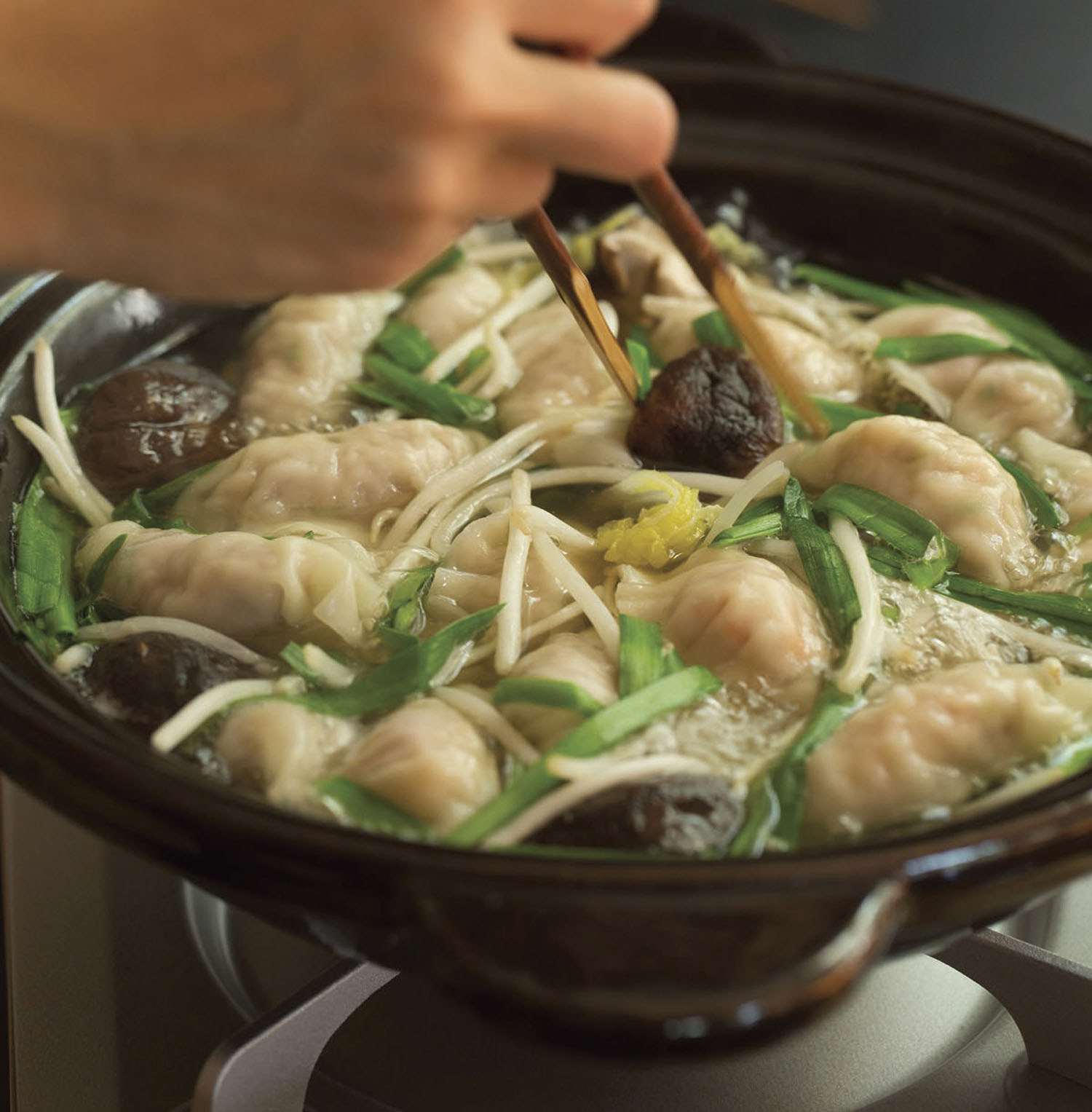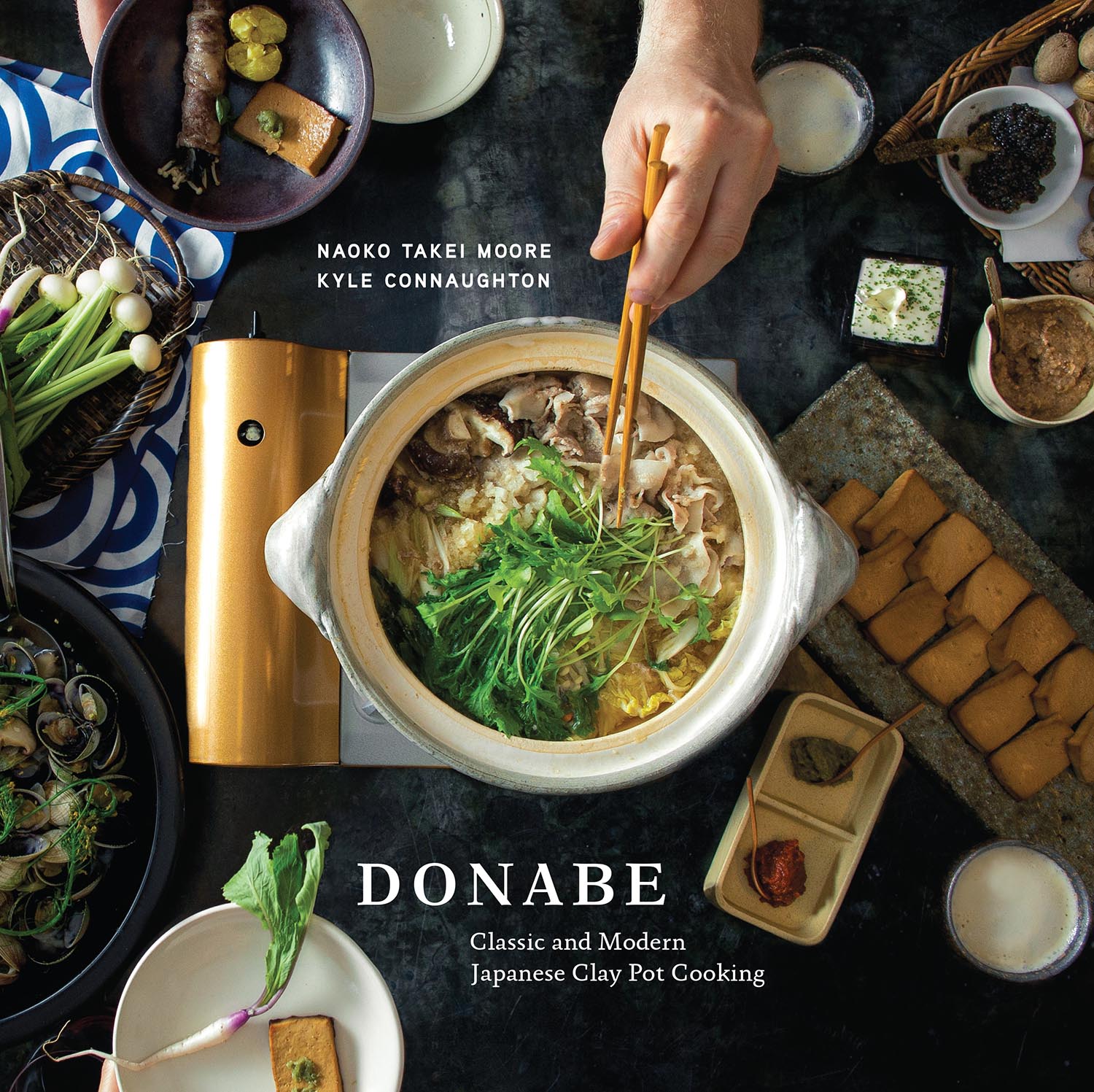Recipe for Gyoza Hot Pot by Naoko Takei Moore
In this recipe, the dumplings are cooked in an earthenware pot, whereas usually they would be browned or fried.

© Eric Wolfinger “Reprinted with permission from Donabe: Traditional and Modern Japanese Clay Pot Cooking by NAOKO TAKEI MOORE AND KYLE CONNAUGHTON Photography by Eric Wolfinger. Copyright 2015. Published by Ten Speed Press, an imprint of Penguin Random House.”
‘Gyoza is a very popular dish in Japan. We eat these dumplings browned, fried, steamed, or poached. So, why not try gyoza cooked in a donabe?’ asks Naoko Takei Moore in the preamble to this recipe for gyoza nabe, taken from her book Donabe – Classic and Modern Japanese Clay Pot Cooking, co-written with chef Kyle Connaughton.
The former now runs TOIRO, a physical shop located in Los Angeles and also found online, where she sells handmade donabe (earthenware pots) imported from Japan. It was her expertise and knowledge of these pots, designed to cook food over a naked flame, that gave her the idea for this recipe. To accompany the gyoza, she recommends adding soy sauce, mirin, rice noodles, and chopped scallions to the broth left over after cooking the dumplings.
In Donabe – Classic and Modern Japanese Clay Pot Cooking, Naoko Takei Moore and Kyle Connaughton present traditional Japanese recipes as well as their more modern versions, sometimes inspired by California, where they both live. In the introduction, they also provide information about the origin, history, and functioning of this pot. As a complement to their own recipes, the pair also share those from renowned chefs who use a donabe in the kitchens at their restaurants, like David Kinch, Namae Shinobu, and Nick Balla.
Serves 4
Ingredients
400 g ground pork
1 tablespoon katakuriko (potato starch)
1 1/2 teaspoons finely grated peeled fresh ginger
1 tablespoon sake
2 tablespoons minced green onion
1 teaspoon toasted sesame oil
1 teaspoon soy sauce
1/4 teaspoon freshly ground black pepper
25 to 30 gyoza wrappers (about 8.5 cm diameter)
1 l kombu dashi
100 ml plus 1 tablespoon sake
3 to 4 leaves green cabbage, cut into large bite-size pieces
6 medium-size shiitake mushrooms, trimmed and halved
150 g mung bean sprouts (crisp white part only)
100 g nira (garlic chives), bottom end trimmed, then cut into 7.5-cm pieces
Miso-vinegar dipping sauce, for serving
Method
To make the gyoza, combine the first eight ingredients for the gyoza in a medium bowl. Knead by hand until the filling is smooth and shiny. Cover with plastic wrap and let rest in the refrigerator for 30 minutes.
To fill the gyoza, mound about 1 tablespoon of the filling in the centre of a wrapper, and use water to wet the edges around half of the wrapper’s edge. Fold the wrapper in half by lifting the dry-edged side. Pinch the edges tightly to seal and place the gyoza on the baking tray lined with parchment paper. Repeat the process with the remaining wrappers until the filling is gone. Cover the dumplings with a damp paper towel until ready to cook. You can make them about 30 to 60 minutes in advance; any longer and the bottom of the gyoza wrappers becomes soggy.
Combine the dashi and sake in a donabe. Cover and bring to a simmer over a medium-high heat. Add the cabbage and cook until slightly tender, about 30 to 60 seconds. Add half the gyoza and half the shiitake; return to a simmer. Simmer for a couple of minutes, and then add half the bean sprouts and half the nira. Cook for another minute or until everything is cooked through and then remove from the heat.
Serve with miso-vinegar dipping sauce.
Donabe – Classic and Modern Japanese Clay Pot Cooking (2015), by Naoko Takei Moore and Kyle Connaughton, is published by Ten Speed Press.
Originally from Japan, Naoko Takei Moore has lived in Los Angeles since 2001. A graduate of the Le Cordon Bleu programme at the California School of Culinary Arts, she also holds a Wine Expert certificate from the Japan Sommelier Association. Kyle Connaughton began his career in Los Angeles, working as an apprentice in one of the oldest Japanese restaurants in the city. After working in Japan alongside chef Michel Bras, among others, he returned to California where he now runs Single Thread Farms, a three-Michelin-starred restaurant.

© Eric Wolfinger “Reprinted with permission from Donabe: Traditional and Modern Japanese Clay Pot Cooking by NAOKO TAKEI MOORE AND KYLE CONNAUGHTON Photography by Eric Wolfinger. Copyright 2015. Published by Ten Speed Press, an imprint of Penguin Random House.”
TRENDING
-
The Tattoos that Marked the Criminals of the Edo Period
Traditional tattoos were strong signifiers; murderers had head tattoos, while theft might result in an arm tattoo.

-
Paris, Tokyo: Robert Compagnon
With his co-chef and talented wife, Jessica Yang, Robert Compagnon opened one of the top new restaurants in Paris: Le Rigmarole.
 3:31
3:31 -
Chiharu Shiota, Red Threads of the Soul
Last year, more than 660,000 people visited the retrospective 'Chiharu Shiota: The Soul Trembles' exhibit at the Mori Art Museum.

-
‘Before Doubting Others, Doubt Yourself. Who Can Truly Say a Dish Isn’t What It Used to Be?’
In ‘A Non-Conformist’s Guide to Surviving Society’, author Satoshi Ogawa shares his strategies for navigating everyday life.

-
The Story of Sada Yacco, the Geisha who Bewitched Europe
Described by Dazed magazine as the first beauty influencer, she has been restored to her former glory since 2019.





